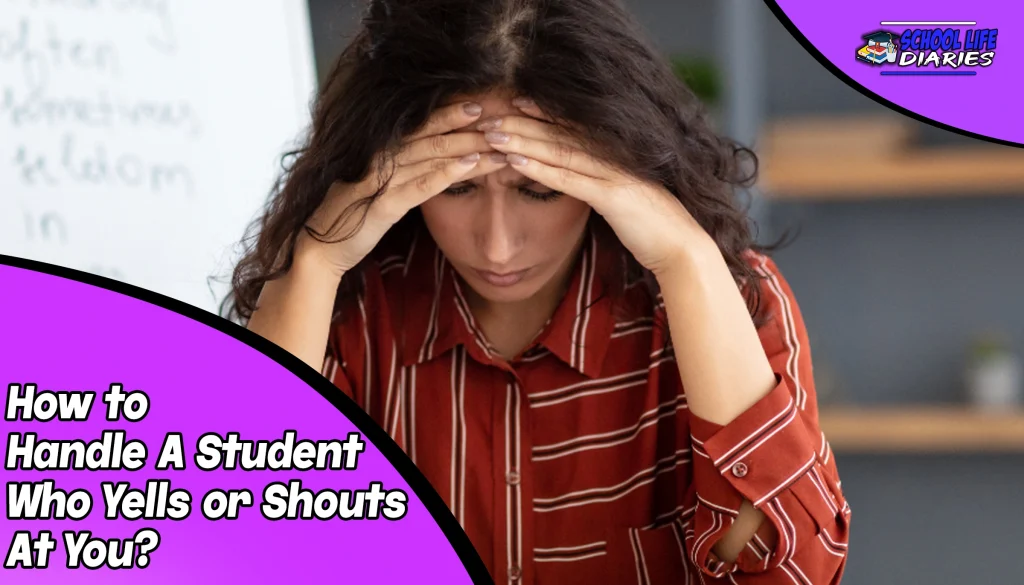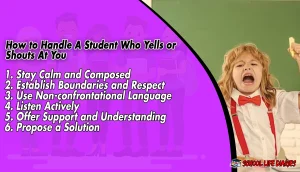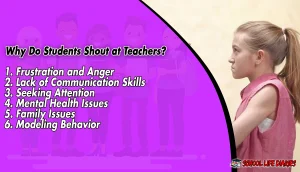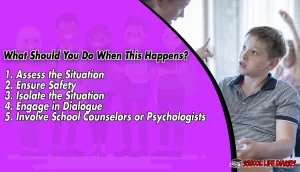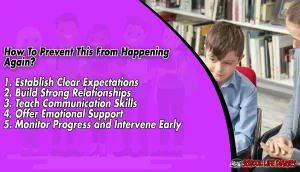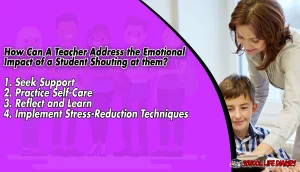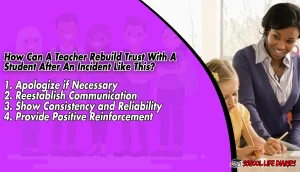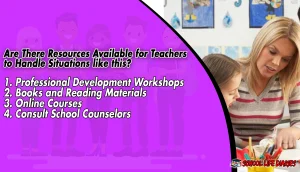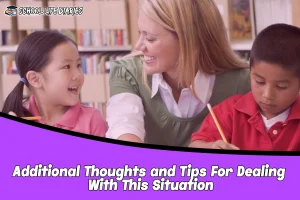Dealing with a student who yells or shouts at you can be a challenging and distressing situation and learning how to handle a student for educators. Understanding the reasons behind such behavior, learning how to handle it effectively, preventing future occurrences, managing emotional impact, rebuilding trust, and finding available resources are essential aspects for educators to navigate these difficult situations. This article will explore these aspects in detail to equip educators with strategies to manage such incidents and create a conducive learning environment.
How to Handle A Student Who Yells or Shouts At You?
Dealing with a student who yells or shouts at you necessitates a composed and strategic approach. Here are steps to effectively manage such situations:
1. Stay Calm and Composed
Maintaining a calm demeanor is crucial when faced with a student who is yelling or shouting. Reacting emotionally can escalate the situation and make it more challenging to resolve.
2. Establish Boundaries and Respect
Communicate to the student that yelling or shouting is not an acceptable form of communication. Emphasize the importance of mutual respect and appropriate behavior within the classroom.
3. Use Non-confrontational Language
Engage the student in a calm and non-aggressive manner. Choose your words carefully, focusing on understanding their concerns rather than engaging in a power struggle.
4. Listen Actively
Allow the student to express their feelings and concerns. Actively listen to what they are saying, and acknowledge their emotions without endorsing their inappropriate behavior.
5. Offer Support and Understanding
Express empathy toward the student’s feelings and reassure them that their concerns will be addressed appropriately.
6. Propose a Solution
Collaborate with the student to find a constructive resolution to the issue. Encourage them to suggest alternatives or compromises to improve the situation.
Why Do Students Shout at Teachers?
Students may resort to shouting at teachers for various reasons. Frustration and anger stemming from academic challenges or personal issues can overwhelm them, leading to an outburst. In some cases, students lack proper communication skills to express their concerns appropriately, resulting in heightened emotions and raised voices. Seeking attention is another possible motive, especially if a student feels neglected or disregarded. Understanding the reasons why students shout at teachers is vital for addressing this behavior effectively. Several factors might contribute to a student raising their voice towards an educator:
1. Frustration and Anger
Students may shout out of frustration or anger when they encounter academic difficulties, conflicts with peers, or personal challenges.
2. Lack of Communication Skills
Some students might lack effective communication skills, resorting to shouting as a way to express their thoughts and emotions.
3. Seeking Attention
Students may shout to gain attention, especially if they feel neglected or overlooked in the classroom.
4. Mental Health Issues
Underlying mental health problems can lead to heightened emotions and outbursts, including yelling.
5. Family Issues
Issues at home, such as a lack of a stable environment or conflict within the family, can manifest as aggressive behavior in the classroom.
6. Modeling Behavior
Students may mimic inappropriate behavior they witness at home or in their community, believing it is an acceptable way to communicate.
What Should You Do When This Happens?
Dealing with a student shouting requires a well-planned response to maintain order in the classroom and support the student’s emotional well-being:
1. Assess the Situation
Quickly evaluate the severity of the outburst and the potential impact on the class and the student.
2. Ensure Safety
Prioritize the safety of all students and yourself during the incident, intervening if necessary to prevent harm.
3. Isolate the Situation
Remove the student from the classroom to a designated quiet space where they can calm down and discuss the issue privately.
4. Engage in Dialogue
Once in a calmer setting, engage in a respectful conversation with the student to understand the reasons behind their outburst and work towards a resolution.
5. Involve School Counselors or Psychologists
If the behavior persists, seek guidance from school counselors or psychologists who can provide further insights and interventions.
How To Prevent This From Happening Again?
Preventing future outbursts involves creating a positive classroom environment and fostering healthy teacher-student relationships:
1. Establish Clear Expectations
Clearly outline classroom rules and expectations, emphasizing respectful behavior and appropriate communication.
2. Build Strong Relationships
Invest time in building trust and strong relationships with students, allowing them to feel comfortable discussing their concerns.
3. Teach Communication Skills
Incorporate communication skills into the curriculum to equip students with appropriate ways to express themselves and handle conflicts.
4. Offer Emotional Support
Create an atmosphere where students feel safe discussing their emotions and seeking help when needed.
5. Monitor Progress and Intervene Early
Regularly assess student behavior and intervene promptly if signs of distress or frustration arise.
How Can A Teacher Address the Emotional Impact of a Student Shouting at them?
Addressing the emotional impact of a student shouting at a teacher necessitates a careful and empathetic approach. Initially, it’s essential for the teacher to acknowledge their own feelings and reactions, allowing for self-reflection and understanding the extent of the emotional impact. Seeking support from colleagues, supervisors, or mental health professionals to process these emotions is beneficial. Engaging in self-care practices like mindfulness, exercise, or hobbies can help in managing stress and anxiety. Dealing with a student’s outburst can have a lasting emotional impact on a teacher. Here’s how educators can address this impact:
1. Seek Support
Share your experience with trusted colleagues, supervisors, or mental health professionals to process your emotions and gain coping strategies.
2. Practice Self-Care
Prioritize self-care activities such as exercise, mindfulness, hobbies, and spending time with loved ones to manage stress and anxiety.
3. Reflect and Learn
Reflect on the incident, focusing on what you learned from the experience and how you can handle similar situations better in the future.
4. Implement Stress-Reduction Techniques
Incorporate stress-reducing practices into your daily routine, such as deep breathing, progressive muscle relaxation, or journaling.
How Can A Teacher Rebuild Trust With A Student After An Incident Like This?
Rebuilding trust with a student after an incident where they have yelled or shouted at a teacher involves delicate and intentional steps. Acknowledging the incident and its impact is crucial, demonstrating to the student that their feelings and reactions are valid and acknowledged. An open and honest conversation, devoid of judgment, allows the teacher to understand the student’s perspective and concerns.
Providing a clear pathway for improved communication and behavior, while offering consistent support and encouragement, helps in reinstating trust. Demonstrating reliability, keeping promises, and showcasing a genuine commitment to the student’s well-being and growth are paramount in the journey of rebuilding trust and fostering a positive teacher-student relationship. Rebuilding trust with a student after an incident of shouting involves patience, understanding, and intentional efforts:
1. Apologize if Necessary
If you believe your actions contributed to the incident, offer a sincere apology to the student.
2. Reestablish Communication
Initiate open and honest communication with the student, demonstrating your willingness to listen and understand their perspective.
3. Show Consistency and Reliability
Consistently uphold the rules and expectations while being reliable and predictable in your actions and decisions.
4. Provide Positive Reinforcement
Acknowledge the student’s efforts to improve their behavior and provide positive reinforcement for their progress.
Are There Resources Available for Teachers to Handle Situations like this?
Numerous resources are available to assist educators in handling student outbursts effectively:
1. Professional Development Workshops
Participate in workshops focusing on classroom management, conflict resolution, and understanding student behavior.
2. Books and Reading Materials
Explore books and reading materials specifically designed to guide teachers in managing challenging classroom situations.
3. Online Courses
Enroll in online courses covering topics such as student psychology, communication strategies, and emotional intelligence.
4. Consult School Counselors
Collaborate with school counselors to gain insights and advice on managing challenging student behaviors.
Additional Thoughts and Tips For Dealing With This Situation
In addition to the above strategies, here are some extra tips to handle student outbursts effectively:
- Practice Patience and Empathy: Put yourself in the student’s shoes to better understand their perspective and respond with empathy.
- Utilize De-escalation Techniques: Learn and implement de-escalation techniques to defuse tense situations and prevent them from escalating.
- Involve Parents or Guardians: Keep open lines of communication with parents or guardians, involving them in addressing the behavior and finding solutions.
- Monitor Progress and Provide Feedback: Continuously monitor the student’s progress, offering constructive feedback and encouragement for their improvements.
- Encourage Peer Support: Foster a supportive classroom environment where students are encouraged to support and help each other.
Conclusion: How to Handle A Student Who Yells or Shouts At You?
Navigating a situation where a student shouts or yells at a teacher requires empathy, assertiveness, and understanding. It is not just about managing the immediate incident, but also about fostering a long-term relationship based on trust, respect, and effective communication. Understanding the reasons behind such behavior, ranging from frustration and communication challenges to external influences like family dynamics, is crucial. Addressing these underlying issues is fundamental to preventing future outbursts and establishing a conducive learning environment.
The emotional impact on the teacher should not be underestimated. Acknowledging and addressing these emotional aspects through self-reflection, seeking support, and practicing stress reduction techniques is vital for a teacher’s overall well-being and effectiveness in the classroom. Rebuilding trust with the student after an incident requires patience, consistency, and genuine efforts to mend the relationship. It involves a commitment to understanding the student’s perspective, providing positive reinforcement, and demonstrating reliability in actions and decisions.
In conclusion, dealing with a student who yells or shouts at a teacher demands a holistic approach that encompasses understanding, communication, emotional management, and access to appropriate resources. By addressing the root causes, implementing effective strategies, and fostering an environment of empathy and respect, educators can not only manage such incidents but also promote a culture of understanding and growth within the classroom.

